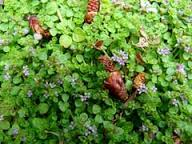Mints, mentha species
 Pennyroyal, Mentha pulegium
Pennyroyal, Mentha pulegium
The leaves are used raw or cooked, as a flavouring in salads or cooked foods. A spearmint-like flavour, though rather coarser, it is not used very often in Britain.
A herb tea is made from the fresh or dried leaves. For drying, it should be harvested as the plant comes into flower.
Pennyroyal has been used for centuries in herbal medicine. Its main value is as a digestive tonic where it increases the secretion of digestive juices and relieves flatulence and colic.
Pennyroyal also powerfully stimulates the uterine muscles and encourages menstruation, thus it should not be prescribed for pregnant women since it can procure abortions, this is especially the case if the essential oil is used.
A tea made from the leaves has traditionally been used in the treatment of fevers, headaches, minor respiratory infections, digestive disorders, menstrual complaints and various minor ailments.
It is occasionally used as a treatment for intestinal worms.
Externally, an infusion is used to treat itching and inflamed skin disorders such as eczema and rheumatic conditions such as gout.
The leaves are harvested in the summer as the plant comes into flower and are dried for later use.
The essential oil in the leaves is antiseptic, though it is toxic in large doses.
An essential oil is obtained from the whole plant, used in soap making and as a cleanser for fabrics.
The plant has a low spreading habit and can be used as a ground cover, though it is somewhat sparse in the winter and can be invaded by the more aggressive weeds.
The growing or dried plant repels fleas, ants, moths, mice etc. Rats and mice intensely dislike the smell of mint.
A strong infusion applied to the face will keep gnats away in the summer.
 Corsican mint, Mentha requienii
Corsican mint, Mentha requienii
The leaves are edible raw or cooked. A very strong peppermint-like aroma, it is used as a flavouring in salads, cooked foods and liqueurs.
A herb tea is made from the leaves.
A tea made from the leaves of most mint species has traditionally been used in the treatment of fevers, headaches, digestive disorders and various minor ailments.
The leaves are harvested as the plant comes into flower and can be dried for later use.
The essential oil in the leaves is antiseptic, though it is toxic in large doses.
An essential oil with a strong peppermint scent is obtained from the whole plant.
Rats and mice intensely dislike the smell of mint. The plant was therefore used in homes as a strewing herb and has also been spread in granaries to keep the rodents off the grain.
An ornamental ground cover plant, very low growing..
I did find this plants roots don’t go deep at all, so in summer the plants were suffering in dry weather.
Other mints, like Mentha piperita - white, black and eau the cologne mints; Mentha x villosa alopecuroides - apple mint; and mentha avensis, the wild mint, all have a similar profile:
The leaves are used raw or cooked. A mint flavour, they are used as a flavouring in salads or cooked foods.
An essential oil from the leaves and flowers is used as a flavouring in sweets, chewing gum, ice cream etc.
A herb tea is made from the fresh or dried leaves.
Mint is a very important and commonly used remedy, being employed by allopathic doctors as well as herbalists. It is also widely used as a domestic remedy.
A tea made from the leaves has traditionally been used in the treatment of fevers, headaches, digestive disorders (especially flatulence) and various minor ailments.
The herb is abortifacient, anodyne, antiseptic, antispasmodic, carminative, cholagogue, diaphoretic, refrigerant, stomachic, tonic and vasodilator.
An infusion is used in the treatment of irritable bowel syndrome, digestive problems, spastic colon etc.
Externally a lotion is applied to the skin to relieve pain and reduce sensitivity.
The leaves and stems can be used fresh or dried, they are harvested for drying in August as the flowers start to open.
The essential oil in the leaves is antiseptic and strongly antibacterial, though it is toxic in large doses.
When diluted it can be used as an inhalant and chest rub for respiratory infections.
The essential oil is used in aromatherapy. Its keyword is 'Cooling'.
An essential oil obtained from the whole plant is used in perfumery. It is also an ingredient of oral hygiene preparations, toiletries etc.
Peppermint leaves are used as an ingredient of pot-pourri.
The plant repels insects, rats etc., rats and mice intensely dislike the smell of mint. The plant was therefore used in homes as a strewing herb and has also been spread in granaries to keep the rodents off the grain.
Succeeds in most soils and situations so long as the soil is not too dry. Grows well in heavy clay soils. A sunny position is best for the production of essential oils, but the plant also succeeds in partial shade. Most mints have fairly aggressive spreading roots and, unless you have the space to let them roam, they need to be restrained by some means such as planting them in containers that are buried in the soil. They are good ground covering plants, provided you have the space for them.
The flowers are very attractive to bees and butterflies.
A good companion for growing near cabbages and tomatoes, helping to keep them free of insect pests.
Members of this genus are rarely if ever troubled by browsing deer.
